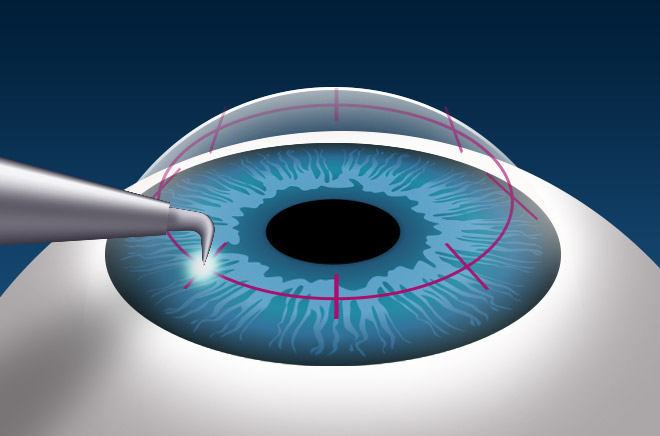
How Long Does Cornea Transplant Surgery Take?
Aug 26, 2025
A cornea transplant, also known as keratoplasty, is a delicate surgical procedure that replaces a damaged or diseased cornea with healthy donor tissue. Since the cornea plays a crucial role in focusing light onto the retina, its health directly affects vision clarity. Patients often ask, “How long does cornea transplant surgery take?” Understanding the procedure duration, recovery process, and factors that influence outcomes can help individuals prepare better for surgery.
Whether you are exploring Cornea treatment in Delhi, considering a consultation at Vision Eye Centre, this article provides a complete explanation of the surgery time, steps involved, and recovery journey.
Understanding Cornea Transplant Surgery
A cornea transplant becomes necessary when the cornea is scarred, swollen, or distorted due to conditions like keratoconus, corneal infections, dystrophies, or injuries. There are different types of corneal transplants, such as:
-
Penetrating Keratoplasty (PK): Full-thickness cornea replacement.
-
DSEK/DMEK (Endothelial Keratoplasty): Replacement of the innermost corneal layer.
-
Lamellar Keratoplasty: Partial corneal replacement.
Each type of surgery has a slightly different timeline and recovery period. While the question “how long does cornea transplant surgery take?” may sound simple, the answer depends on the surgical technique, the patient’s condition, and the surgeon’s expertise.
How Long Does the Surgery Take?
The average cornea transplant surgery time is usually between 1 to 2 hours. However, the exact duration depends on the complexity of the case and the surgical method chosen.
-
Penetrating Keratoplasty (PK): Since it involves replacing the entire corneal thickness, this method typically takes around 2 hours.
-
Endothelial Keratoplasty (DSEK/DMEK): These are less invasive and may take around 45 minutes to 1 hour.
-
Lamellar Keratoplasty: The time varies depending on the layers being replaced, but typically ranges from 1 to 1.5 hours.
During the surgery, patients are usually under local anesthesia with sedation, or in some cases, general anesthesia. This ensures the eye remains completely still while the Cornea Specialist Doctor in Delhi performs the procedure.
Factors that Influence Surgery Time
While the average duration is clear, several factors can influence the overall cornea transplant surgery time:
-
Type of Transplant: Full-thickness procedures take longer than partial transplants.
-
Patient’s Condition: Scarring, infection, or previous eye surgeries can make the procedure more complex.
-
Surgeon’s Expertise: Experienced surgeons, such as those at Vision Eye Centre, can perform the surgery more efficiently while ensuring precision.
-
Anesthesia Type: General anesthesia may require additional preparation time compared to local anesthesia.
-
Donor Tissue Preparation: Sometimes donor corneal tissue needs special preparation, adding to the overall time.
-
Intraoperative Complications: Rare but possible complications can extend surgery time.
Ultimately, the duration is customized to ensure both safety and success of the transplant. While time is important, patients should focus more on the quality of surgery and post-operative recovery.
What Happens During the Surgery Step-by-Step?
Understanding the step-by-step process helps patients feel less anxious and more prepared. A corneal specialist usually follows these stages during the surgery:
Preoperative Preparation
Before the surgery begins, patients are given either local anesthesia (to numb the eye area) or general anesthesia (to make them sleep through the procedure). The surgical team thoroughly cleans the area around the eye to prevent infection and places sterile covers around it. This ensures a safe environment and prepares the patient for the delicate process ahead.
Donor Tissue Preparation
The next stage involves preparing the donor cornea. The donated tissue is carefully examined by the eye bank and then by the surgeon to confirm its clarity and suitability. Depending on whether the patient requires a full-thickness corneal replacement (penetrating keratoplasty) or a partial one (DSEK, DMEK, or lamellar keratoplasty), the donor tissue is shaped and prepared accordingly.
Removal of the Damaged Cornea
Once the donor cornea is ready, the surgeon makes a precise circular cut on the patient’s cornea using specialized instruments. The diseased or scarred portion of the cornea is gently removed. This step requires extreme precision, as the surgeon must ensure the opening is perfectly shaped to fit the donor graft.
Placement of the Donor Cornea
After removing the unhealthy tissue, the donor cornea is placed into the prepared opening. The surgeon positions it carefully to align with the surrounding eye tissue. In traditional techniques, the graft is secured with ultra-fine stitches, while in newer, advanced methods, fewer or no sutures may be required.
Final Adjustments and Protection
Before completing the surgery, the surgeon makes final adjustments to ensure the graft sits smoothly without folds or irregularities. Once everything is in place, a protective shield is placed over the eye to guard it from accidental rubbing or exposure to dust and light. The patient is then taken to the recovery area for monitoring before being discharged.
Cornea Transplant Recovery Time
While the surgery itself takes only 1–2 hours, the recovery time from a cornea transplant is much longer. Unlike other surgeries where healing is rapid, the cornea heals slowly, and vision improvement can take several months.
-
Immediate Recovery: Patients may go home the same day but must rest and avoid strain.
-
First Few Weeks: Initial healing occurs, but vision may remain blurry. Stitches (if placed) help keep the cornea stable.
-
3–6 Months: Most patients begin to see clearer results during this time. Some may need new glasses or contact lenses.
-
Full Recovery: It can take up to 12–18 months for complete healing and stabilization of vision.
Important to note: cornea transplant recovery time varies depending on the type of surgery. Endothelial keratoplasty generally heals faster than full-thickness keratoplasty.
Tips for Faster Recovery After a Cornea Transplant
The success of a cornea transplant depends not just on surgery but also on careful recovery. Following the doctor’s advice is crucial for protecting the new cornea and improving outcomes. Here are some important tips:
-
Follow Medication Strictly
-
Use prescribed eye drops (antibiotics and steroids) as directed to prevent infection and reduce inflammation.
-
-
Protect the Eye
-
Always wear the protective shield provided by your surgeon, especially while sleeping.
-
Avoid rubbing or pressing the eye.
-
-
Limit Physical Strain
-
Avoid heavy lifting, bending over, or strenuous exercise for several weeks.
-
Gentle walks are fine, but wait for your doctor’s approval before resuming normal activities.
-
-
Maintain Hygiene
-
Keep your hands clean before touching your face or eye area.
-
Avoid dusty or smoky environments that may irritate the eye.
-
-
Attend Follow-Up Visits
-
Regular check-ups with your Cornea Specialist Doctor in Delhi help detect any early signs of rejection or complications.
-
Risks and Complications to Be Aware Of
While cornea transplant surgery has a high success rate, like any surgery, it carries certain risks. Being aware of them helps patients prepare better:
-
Graft Rejection: The body may recognize the donor cornea as foreign and attack it. Symptoms include redness, sensitivity to light, decreased vision, and pain.
-
Infection: Though rare, infections can occur if hygiene or post-op care is neglected.
-
Glaucoma or Cataracts: Sometimes, pressure changes in the eye or steroid drops may lead to secondary conditions.
-
Astigmatism: Irregular healing of the cornea can cause blurred or distorted vision.
-
Need for Repeat Surgery: In a small percentage of cases, the graft may fail and require another transplant.
Most complications are manageable when detected early. That’s why patients must promptly report unusual symptoms and stay under regular follow-up care.
Success Rate and Long-Term Outlook
Cornea transplant surgery is one of the most successful organ transplants performed today. Studies show that the success rate can be as high as 85–90%, depending on the underlying condition and type of transplant performed.
-
Full-thickness transplants (PK): These have slightly longer healing times but remain effective for many patients.
-
Endothelial keratoplasty (DSEK/DMEK): These newer techniques have higher success rates, faster healing, and fewer complications.
-
Partial-thickness transplants: Reduce the risk of rejection and often provide clearer vision in the long term.
Most patients regain functional vision that allows them to perform daily tasks comfortably. However, glasses or contact lenses may still be needed for fine vision correction. In some cases, laser vision correction may also be considered after full recovery.
Conclusion
A cornea transplant is a life-changing surgery that can restore sight and improve the quality of life for people with damaged or diseased corneas. While the cornea transplant surgery time is relatively short—usually between 45 minutes and 2 hours—the real journey lies in the recovery phase, which can take several months to over a year.
Choosing the right center is critical for long-term success. With advanced technology, experienced specialists, and a patient-first approach, Vision Eye Centre has established itself as a trusted name for corneal treatment.
Frequently Asked Questions
Q1. How long does cornea transplant surgery take?
The surgery usually takes 45 minutes to 2 hours, depending on whether it’s a full-thickness or partial transplant.
Q2. What is the recovery time from a cornea transplant?
Recovery is gradual. Initial healing takes weeks, but full vision recovery may take 12–18 months.
Q3. Is the surgery painful?
No, patients are under anesthesia. Some mild discomfort or irritation may occur after surgery, but it is usually manageable with prescribed medication.
Q4. Can vision return to normal after a cornea transplant?
Many patients regain clear vision, though glasses or contact lenses may still be required for fine-tuning. Outcomes depend on the underlying eye condition.
Q5. How do I know if my body is rejecting the new cornea?
Warning signs include redness, pain, blurred vision, and sensitivity to light. Immediate consultation with a corneal specialist is necessary if these occur.
Q6. Are cornea transplants permanent?
Yes, they often last for 10–20 years or longer, though some patients may need repeat surgery if the graft fails over time.
Q7. Can I drive after a cornea transplant?
Driving should only be resumed once your doctor confirms that your vision is stable and safe.

